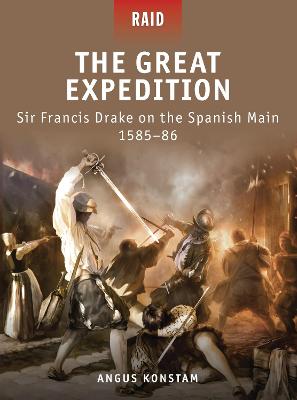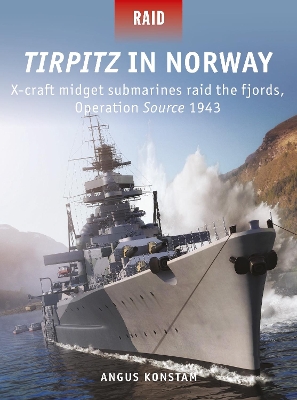Raid
5 total works
In 1585, the English launched a pre-emptive strike against Spain, by attacking her New World colonies. Led by Sir Francis Drake, in command of 21 ships and 1,800 soldiers, the expedition struck first at the Canary Islands, then attacked the city of Santo Domingo and the treasure port of Cartagena. Frequently outnumbered, Drake's soldiers won an series of spectacular victories and, laden with treasure, sailed home to a hero's welcome.
In April 1713 the War of the Spanish Succession came to an end. During the conflict hundreds of privateers - licenced pirates - preyed on enemy shipping throughout the Caribbean. These privateers now found themselves out of a job, and many turned to piracy. One of theme was Edward Teach - more popularly known as "Blackbeard". He joined the pirates in New Providence (now Nassau) in the Bahamas, and by early 1717 he had become a pirate captain. From then on he caused havoc off the North American seaboard, in the West Indies and off Honduras, before appearing off Charleston, South Carolina in May 1718. He blockaded this major port for a week, an act that made Blackbeard the most notorious pirate of his day.
In September 1943, under the cover of darkness, six British midget submarines crept into the heart of enemy territory, penetrating a heavily guarded Norwegian fjord in an attempt to eliminate the threat of the powerful German battleship, the Tirpitz. Numerous previous attempts to attack the ship from both air and sea had failed, and this mission was carefully strategized, and undertaken by skilled operatives who had undergone extensive training in an isolated sea loch. Though five of the six X-Craft submarines were either lost or captured, two crews had just enough time to lay their explosive charges, which detonated after they were forced to the surface, putting the Tirpitz out of action for a crucial six-month period. Masterminded from a top-secret naval headquarters on the east coast of Scotland, Operation Source has been memorialised as one of the most daring naval raids of World War II.
This new study tells the complete story of this epic operation in unparalleled detail, supported by full-colour illustrations and contemporary photography.
This new study tells the complete story of this epic operation in unparalleled detail, supported by full-colour illustrations and contemporary photography.
At the outset of World War II, Scapa Flow was supposed to be the safe home base of the British Navy - nothing could penetrate the defences of this bastion. So how, in the dead of night, was Gunther Prien's U-47 able to slip through the line of protective warships to sink the mighty Royal Oak? This book provides the answer with an account of one of the most daring naval raids in history. Drawing on the latest underwater archaeological research, this study explains how Prien and his crew navigated the North Sea and Kirk Sound to land a devastating blow to the British. It reveals the level of disrepair that Scapa Flow had fallen into, and delves into the conspiracy theories surrounding the event, including an alleged cover-up by the then First Sea Lord, Winston Churchill.
At the outbreak of World War II the German Kriegsmarine still had a relatively small U-boat arm. To reach Britain's convoy routes in the North Atlantic, these boats had to pass around the top of the British Isles - a long and dangerous voyage to their "hunting grounds". Germany's larger surface warships were much better suited to this kind of long-range operation. So, during late 1939 the armoured cruiser Deutschland, and later the battlecruisers Scharnhorst and Gneisenau were used as commerce raiders, to strike at Allied convoys in the North Atlantic. These sorties met with mixed results, but for Germany's naval high command they showed that this kind of operation had potential. Then, the fall of France, Denmark and Norway in early 1940 dramatically altered the strategic situation. The Atlantic was now far easier to reach, and to escape from.
During 1940, further moderately successful sorties were made by the cruisers Admiral Scheer and Admiral Hipper. By the end of the year, with British mercantile losses mounting to surface raiders and U-Boats, plans were developed for a much larger raid, first using both cruisers, and then the two battlecruisers. The climax of this was Operation Berlin, the Kriegsmarine's largest and most wide-ranging North Atlantic sortie so far. Scharnhorst and Gneisenau remained at sea for two months, destroying 22 Allied merchant ships, and severely disrupting Britain's lifeline convoys. So, when the operation ended, the German commander, Admiral Lütjens was ordered to repeat his success - this time with the brand new battleship Bismarck. The rest, as they say, is history. These earlier Atlantic raids demonstrated that German surface ships could be highly effective commerce raiders. For those willing to see though, they also demonstrated just how risky this strategy could be. Covering a fascinating and detailed analysis of the Kriegsmarine’s Atlantic raids between 1939 and 1941, this book will appeal to readers interested in World War II and in particular in Germany’s naval operations.
During 1940, further moderately successful sorties were made by the cruisers Admiral Scheer and Admiral Hipper. By the end of the year, with British mercantile losses mounting to surface raiders and U-Boats, plans were developed for a much larger raid, first using both cruisers, and then the two battlecruisers. The climax of this was Operation Berlin, the Kriegsmarine's largest and most wide-ranging North Atlantic sortie so far. Scharnhorst and Gneisenau remained at sea for two months, destroying 22 Allied merchant ships, and severely disrupting Britain's lifeline convoys. So, when the operation ended, the German commander, Admiral Lütjens was ordered to repeat his success - this time with the brand new battleship Bismarck. The rest, as they say, is history. These earlier Atlantic raids demonstrated that German surface ships could be highly effective commerce raiders. For those willing to see though, they also demonstrated just how risky this strategy could be. Covering a fascinating and detailed analysis of the Kriegsmarine’s Atlantic raids between 1939 and 1941, this book will appeal to readers interested in World War II and in particular in Germany’s naval operations.




